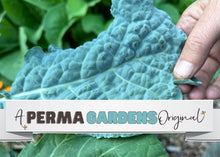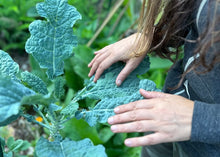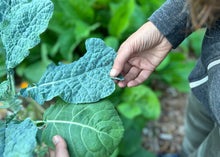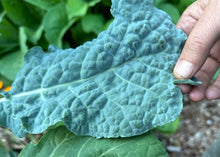
Are you looking for something delicious and different in your garden? Look no further, because now you can have this beautiful blue kale growing in your garden. Blue Belly is a natural hybrid that arose out of our perennial kale breeding project. It has a noticeable blue tint to its leaves, which becomes pronounced in the heat of the summer. We named it after our local Blue Belly lizard because it has a beautiful texture to its leaves. It's a striking contrast in the garden and is sure to be a conversation starter. (Brassica oleracea)
*Rooted plants of this variety will be an exact clone of the mother. Seeds will exhibit genetic diversity and you'll see wonderful variations in your plant babies.
We also offer 2 other varieties of Perma Kale: Lilac Lizard & Dwarf Dino.
Why We Love It
Here are some of the reasons why we love the Blue Belly Kale...
1) STRIKING!- Beauty is just as important as function in the garden, and this plant does not disappoint. It's a beautiful blue hue that really stands out.
2) AWESOME TEXTURE - We named it the Blue Belly after our native lizard because it has a wonderful bumpy texture which is delicious in recipes.
3) MAY HANDLE HEAT BETTER - Many plants put on a silvery/blue color to be able to withstand heat more effectively in the summer. Ours has easily handled our 105 degree summer days.
How to Grow It
Here's how to grow your Blue Belly Kale:
| SUN | FULL TO PART-SUN |
| MOISTURE | LIKES GARDEN MOISTURE |
| GROWING ZONES | PERENNIAL OUTDOORS IN USDA ZONES 8-10, CUTTINGS CAN BE OVER-WINTERED INDOORS EVERYWHERE ELSE (Not sure? Find your growing zone here) |
| SIZE | 3-6 FEET TALL & 3 FEET WIDE |
| GROWING |
From cuttings: We like to root cuttings in 4" or 1 gallon pots. Fill with moistened potting soil. Simply bury the cutting halfway in the soil. Tamp around the cutting to secure. Water occasionally to keep the soil moist. That's it! They root super easily and you should see new leaves start popping in 4-8 weeks. We root outside year-round in zone 9 and above. If you're colder than this, keep your potted cutting on a window sill until Spring. Let us know if you need any support. We're here for you! From rooted plant: We trim all of the leaves except for the top leaf for shipping to prevent dehydration. Once you plant into moist soil, it will spring to life for you and immediately start growing leaves. It's best not to let your plant flower as it's getting settled into its new home. Trim off any flowers for the first few months. It will seem to grow slowly for the first couple months as the roots settle in, and then it will boom with growth! PRO TIP: The key for this wonderful, branching perennial green is to harvest often! It will allow for optimal air flow, which will keep your kale happy and healthy. If you live in a cooler growing zone, take a branch cutting in the late Fall and pop into a pot and bring indoors for the winter. You can plant out again in the Spring. |
Here are some pruning tips below:
How to Harvest & Use It
Harvest the outer, largest leaves. We suggest harvesting 1/3 or less of the leaves at a time so the plant can continue to gather sun and photosynthesize. Your Blue Belly Kale will pop up a flower stalk in the spring. The immature flower buds can be harvested and eaten just like broccoli (it's the same family). While it's flowering, you'll notice that it doesn't make as many leaves. After the plant is finished flowering, cut off the flower stalks and it will increase its leaf production again and give you leaves all summer, fall, and winter.










